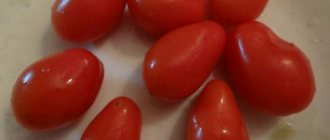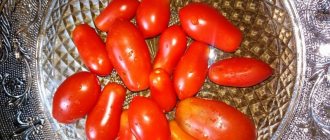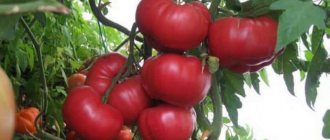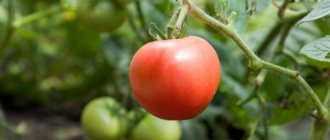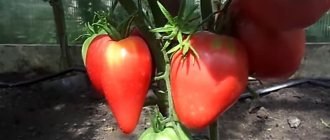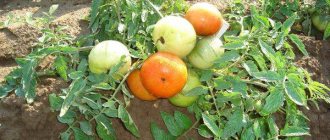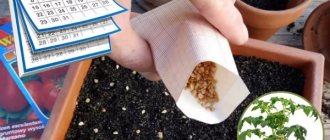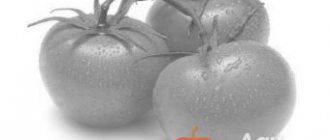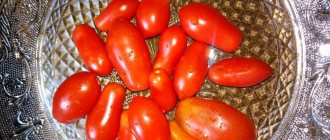The pickling delicacy is a variety that is surprisingly suitable for winter preparations. When pickled or canned, tomatoes are amazingly tasty and have a rich aroma and taste.
| Height | Landing location | Ripening time | Fruit color | Fruit size | Origin | Fruit shape |
| Medium height | Greenhouse, Open ground | Mid-season | Reds | Average | Variety | Plum-shaped or oval |
Description of tomato variety Pickling delicacy with photo
This tomato is a hybrid, bred in 2000. Initially, it was included in the register of breeding achievements of Russia, but today it is not listed there. Nevertheless, many summer residents successfully grow tomatoes, a pickling delicacy. In most areas it can be cultivated in greenhouses, but in the southern regions it can be grown in open beds.
Main characteristics of the pickling delicacy tomato variety:
- determinant (grows to a certain limit);
- short (reaches no more than 80-100 cm in height);
- mid-ripening (fruits have time to form in 95-105 days).
The leaves are large, typical in shape, dark green in color. The foliage is high, the bush is standard, powerful, with strong shoots, so it does not require garter or intensive feeding. The flowers are small, yellow.
Description of fruits
Pickling delicacy tomatoes have a cylindrical shape, reminiscent of bell peppers or plums. The color is bright red, sometimes interspersed with orange. Unripe fruits are light green with a darker part near the stalk. The surface is glossy with a dense skin, without wrinkles. The ribbing is weakly expressed - mainly near the stalk. The tomatoes are small in size: 5-6 cm in length, weight approximately 100 g.
Each fruit has 4 seed chambers. Collecting seeds is not advisable, since the Pickling Delicacy tomato is a hybrid, not a variety. Therefore, the new generation bushes will not bear fruit. The pulp is dense and quite juicy. The taste is sweetish, refreshing. Summer residents appreciate Pickling Delicacy tomatoes because they are in many ways reminiscent of dessert varieties, although they are easier to grow.
6-8 tomatoes are formed on each brush. Pickling delicacy
Lighting
Access to light to emerging sprouts not only stimulates their rapid germination, but also ensures high yield of the variety. There are several features here:
- Tomato yields will be higher if a bag of seeds is placed in close proximity to a heat source a couple of months before sowing. Thus, a central heating battery gives the “warm-up” of the future harvest at the level of 25-30°C.
- at the time of growing seedlings, the ambient temperature should be from 18 to 23 degrees during the day and from 12 to 15 degrees at night. A window slightly open for ventilation at night will enable early hardening of seedlings;
- The period of the appearance of flowers and the beginning of budding, as a rule, coincides with the planting of shoots in the greenhouse. At this time, the sun naturally heats the space to 20-25 degrees, at night the temperature drops to 16-18°C. It is important to ensure that the soil thermometer shows 18-20 during the day, and not lower than 16 degrees Celsius at night.
Characteristics of tomato variety Pickling delicacy
The tomato belongs to the mid-season or mid-early group. From the moment the first shoots appear until they reach the stage of technical maturity (green tomatoes), 95-105 days pass. Therefore, the first harvest of Pickling Delicacy tomatoes is harvested in mid-June. The fruits can be sent for ripening to a dark, cool place or left on the bush. The main fruiting occurs in July.
Tomato productivity Pickling delicacy and fruiting
Like many other hybrids, the Pickling Delicacy tomato is high-yielding. With proper care, you can remove up to 3-4 kg of tomatoes from 1 bush over the entire season. This is a very good indicator for a determinate variety.
| Conditions | Greenhouse | Open ground |
| From 1 bush, kg | 3-4 | 2,5-3 |
| From 1 m2, kg* | 12-16 | 10-12 |
*On 1 m2 you can place 4 tomato bushes. Pickling delicacy.
Achieving the declared yield is quite simple - for this plant it is better to plant it in a greenhouse. In addition, it is necessary to follow the standard rules of agricultural technology:
- Water regularly with settled water.
- Ventilate the greenhouse.
- Tie the bushes to supports: despite the fact that they are determinate, the branches can bend under the weight of the fruit.
- To plant: all shoots up to the first cluster are removed, leaving a “stump” of 1 cm.
As for feeding, they can be given once a month. The pickling delicacy does not require fertilization. However, if the soil is infertile, nutritional compounds should be added every 2-3 weeks.
The greatest yield can be obtained by growing tomatoes. Pickling delicacy in a greenhouse
Area of application of fruits
Universal tomatoes, suitable for preparing any dish:
- salads;
- soups;
- sauces;
- tomato juice;
- canned vegetables (lecho, caviar and other snacks).
At the same time, the main purpose of pickling delicacy tomatoes, as the name suggests, is whole-fruit canning. Tomatoes have a thick skin, and they are small in size, but the main thing is that they have a very pleasant taste. Therefore, they are ideal for salting and pickling - both in jars and in barrels.
Resistance to diseases and pests
Like many other hybrids, the Pickling Delicacy tomato has good immunity to a number of Solanaceae diseases:
- tobacco mosaic;
- brown spot;
- gray rot;
- Fusarium
However, the bushes can suffer from late blight, and if grown incorrectly (excessive moisture) - from rot. Therefore, seedlings must be treated with a fungicide a few days before transferring them to a permanent place.
In summer, bushes can suffer from various insects (aphids, cutworms, whiteflies) and other pests (slugs, nematodes). Therefore, plants need to be periodically inspected and, if necessary, treated with folk remedies or chemicals.
Characteristics and description of the variety
The pickling delicacy is a mid-season tomato, originally intended for growing in open ground. Refers to the standard forms, which are characterized by a thick, erect stem. This small plant has fruits that resemble plums. Round, elongated tomatoes weigh on average 100-110 grams and do not grow above one meter in height. The color range is from pink to deep red. With proper care from one bush, by the end of the season you can collect up to 3.5 kg from one trunk.
Due to the fairly thick skin and the high content of dry substances in the tomato, the pickling delicacy is indispensable in canning. The fruits do not burst upon contact with boiling water and retain their dense consistency and rich taste, despite chemical treatment.
Advantages and disadvantages of the variety
Tomatoes of this variety are distinguished by a harmonious, balanced taste, which is noted by almost all summer residents. In addition, they are very productive - they can be grown in a greenhouse - both in the middle zone and in other regions (Urals, Siberia).
Pickling delicacy tomatoes have a pleasant, sweetish taste, so they are suitable for preparing any dishes
pros
- stable harvest;
- very pleasant taste, juiciness;
- good keeping quality and transportability;
- attractive appearance;
- stable immunity to most diseases;
- there is no need to form a bush;
- relatively rapid fruit ripening.
Minuses
- the maximum yield can only be obtained in a greenhouse;
- it is necessary to tie it up and step it (up to the first hand);
- no immunity to late blight;
- in dry weather the harvest is much smaller.
Features of cultivation
Seeds can be planted for seedlings 50-60 days before transplantation, approximately in mid-March. In the southern regions, a seedless method of cultivation is allowed - sown directly in open ground at the end of April and covered with film.
The soil can be used either store-bought or your own, for example, from garden soil with peat, humus and compost (equal ratio). It is first disinfected in a weak solution of hydrogen peroxide. The seeds are immersed in a 5% salt composition and those that float are removed.
Initially, seedlings are grown in wooden boxes or containers in greenhouse conditions (under film, with lighting, at a temperature of 25-26 degrees). Then, when the first leaves appear, the shelter is removed, and after the formation of 3 leaves, they are placed in plastic glasses. Grow at room temperature. 10-15 days before transplantation they are hardened at 15-16 degrees.
Since Pickling Delicacy tomato bushes produce a large harvest, they need to be tied to a support
In mid-May, the plants are transplanted into the greenhouse at a distance of 50 cm from each other (and 60 cm between rows). Can be planted linearly or in a checkerboard pattern. Water 1-2 times a week with warm, settled water. Fertilizing is given once a month (complex mineral fertilizer is possible).
To ensure that the soil retains moisture longer, lay a layer of mulch made from peat, hay, straw and other materials. Regularly weed and loosen (especially before watering). During the period of fruit formation, the bushes are tied to a reliable support - otherwise the branches may not withstand. It is not necessary to root, but some gardeners advise removing all branches up to the first flower cluster.
Important! When grown in open ground, the bushes should be replanted at the end of May or at the beginning of June. The night temperature should not fall below 7-8 degrees.
Who planted the Moscow delicacy tomato: 30 photos and reviews
The formal characteristics and description of the variety do not fully answer the question of why gardeners like the Delicatessen tomato so much.
Let's turn to the gardeners themselves for an answer. Marina Zotova, Moscow region: “For several years I have been living in the summer at my dacha, there is a small plot. I'm certainly not a professional, but I'm no longer a beginner either. During this time, I became familiar with some of the subtleties of growing different crops. My family especially loves tomatoes, so I plant most of the area with them.
Anna Gudkova, Saratov: “I’ve been planting this variety for more than 5 years, the harvest is always stable, the tomatoes themselves are to the taste of me and my household, they are suitable for any type of preservation. The germination of the seeds is excellent, the seedlings have never gotten sick over the years, I don’t know if this is due to natural immunity or if I was just lucky. They are completely unpretentious in care and are suitable for those who are just learning to grow tomatoes.”
- 1 Description of the best varieties of tomatoes for pickling and canning
- 2 Tomato variety “Pickling Delicacy”: photos, reviews, description, characteristics and yield
- 3 Who planted the Moscow delicacy tomato: 30 photos and reviews
- 4 Tomato Moscow delicacy: description, photos, reviews of those who planted, creamy, pickling variety, video
- 5 Tomato Pickling delicacy: characteristics and description of the variety, yield, reviews, photos
Not all varieties of tomatoes are suitable for pickling and canning. Attention is paid primarily to the characteristics of the fruit. They should be small in size, with thin skin and dense, sweet flesh.
Late-ripening tomato varieties with smooth harvest ripening are better suited for winter harvesting. As a result, tomatoes are stored for a long time and you can slowly make the snack in large batches.
Successful cultivation is possible in protected and open beds.
Not all varieties of tomatoes are suitable for canning. It is important to take into account varietal characteristics.
Features of tomatoes that are supposed to be used for pickling:
- small fruit size (weight should not exceed 120 g);
- thin and dense skin;
- varieties that are not prone to cracking;
- sugar content of the pulp.
For pickling, it is better to choose tomatoes that have the following characteristics:
- the size of the fruit can be different, the main thing is that it fits into the container;
- tomatoes should contain more pulp than juice;
- presence of a small number of seeds;
- Suitable varieties are not prone to cracks in fruits.
If you use tomatoes with a low sugar content for pickling, the product will quickly deteriorate and become moldy.
To start fermentation processes, lactic acid is needed. The component is found only in certain types of tomatoes.
To determine which variety is best suited for planting in open beds, you should study its characteristics. It is better to choose tomato varieties with a determinate growth pattern and resistance to adverse weather conditions.
Seeds of such varieties as Marisha, Valentina, Sanka, Babushkin Kiss, Nastenka, Sladkaya Grazhd, Danko, Semko-Sinbad are suitable for growing in open ground.
Tomatoes for greenhouses
It is advantageous to grow indeterminate types of tomatoes in a greenhouse, as the yield is high. But such varieties of tomatoes need to establish support; in addition, the stepsons are regularly removed and a bush is formed.
Varieties suitable for growing indoors are less demanding on lighting.
Productivity is not reduced even if there is slight shading. But they are sensitive to temperature changes.
Therefore, it is necessary to maintain a certain level of temperature and humidity in the room.
The following varieties of pickling tomatoes feel great in greenhouse conditions: Kazachka, Lady's Fingers, Legend Tarasenko, Cherry, Hurricane F1, Druzhok F1.
It is recommended to plant productive varieties for harvesting for the winter. In this case, it will be possible to harvest a lot of crops at the same time and do all the work at once.
The best pickling tomato varieties: Rio Grande, Blagovest F1, Fakel, Moscow Delicacy, Miracle of the World.
The following varieties are suitable for pickling: De Barao, Yablonka Rossii, Yubileiny Tarasenko, Lady's Fingers, Date Siberian F1, Children's Sweetness. These tomatoes have strong skin that can withstand high water temperatures without cracking.
The variety is one of the mid-season tomatoes. After 11 days, the fruits have time to set and ripen. The harvest is formed on powerful, small bushes, no more than 70 cm high. Up to 20 tomatoes can be placed on one branch.
The scarlet-colored fruits are cylindrical in shape, do not crack, and retain their shape and color during canning. Their weight is within 85 g. The harvest is stored for a long time and transported over long distances.
Sanka
The low-growing tomato variety Sanka is popular among summer residents. The growth type is determinant, the bushes do not exceed 55 cm in height. Ultra-early ripening limits allow harvesting after 82 days.
The advantages of the variety are increased resistance to cold, numerous yields, and high resistance to almost all tomato diseases.
The fruits reach 130 g, but in the open area the weight is much lower. The bright, scarlet color is not lost even during heat treatment. The pulp is without voids, with a small content of grains.
After 95 days from the time of emergence, round, smooth fruits of a bright red hue, weighing up to 75 g, begin to ripen on the branches. The skin is not prone to cracks, the flesh is sweet and fleshy.
De Barao Tsarsky
The De Barao Tsarskiy variety is suitable for preservation. It is better to grow in a greenhouse; bushes can grow up to three meters.
The ripening period is late. The first fruits begin to form after 123 days. The bush is quite powerful and spreading.
The color of the fruit depends on the variety that was planted. Tomatoes can be red, pink, orange or golden in color. Weight is small, about 88 g. They do not lose their shape and color in marinade or brine.
Pickling varieties of tomatoes can be recognized by such parameters as small fruit size, strong skin, dense and sweet pulp. All these characteristics guarantee good salting, an attractive appearance and a pleasant taste.
The best pickling tomatoes include: Cheerful Gnome, Children's Sweetness, Ladies' Man, Pinocchio, Summer Resident.
Asvon F1
The Asvon F1 hybrid is characterized by early ripening, a determinant type of growth, the height of the bush rarely exceeds 50 cm. The ripening period is within 98 days. The advantages include high yield and good immunity.
The rounded red fruits with a smooth surface weigh 85 g, the pulp is sugary. The skin is dense, which allows the crop to be preserved and transported over long distances. The taste and shape are preserved in salting.
About
Pest and disease control
Before transplanting bushes into open ground, they are treated with any fungicide, following the instructions:
- "Topaz";
- “Tattu;
- "Profit";
- "Ordan";
- "Fundazol".
If insects are detected, insecticides are used:
- "Aktofit";
- "Aktara";
- "Opercat";
- "Decis";
- "Biotlin";
- "Confidor".
You can also use folk remedies - for example, Colorado beetles are lured into jars with pieces of potatoes (the containers are dug into the ground), aphids are destroyed with a solution of ash and laundry soap, and slugs are repelled with crushed walnut or egg shells (scattered along the paths).
Productivity
Variety specifics
As a rule, many gourmet varieties are very capricious and often susceptible to diseases, which cannot be said about the Moscow variety. Tomatoes do not require special treatment with preventive chemicals.
When growing this variety, gardeners rarely encounter fungal and viral diseases.
The advantages of the variety include the following:
- disease resistance;
- high productivity;
- excellent taste;
- versatility;
- ease of cultivation.
The tomato bush is quite powerful. The average height of the crop is 150-180 cm. The bush is tall and needs to be tied up. Anyone who has already planted this variety knows that the plant, due to its power, does not need feeding.
The leaves of the bush are large and green. There is a lot of foliage, regardless of the frequency of watering.
A distinctive feature of this variety is that each subsequent fruit is larger than the previous one, while with ordinary varieties of tomatoes everything is just the opposite.
The tomatoes are cylindrical or pepper-shaped and slightly ribbed. The fruits are dense and taste like bell peppers. The green tomato has a dark green color and a black stalk.
When ripe, the fruits are red. The pulp is not watery, thanks to which the tomatoes are stored for a long time. The taste is excellent. The average weight of the fetus is 90-160 g.
With proper care, you can harvest about 5-7 kg of tomatoes from 1 m².
Many varieties of tomatoes burst during heat treatment. You won’t encounter such a problem with the Moscow delicacy. Stuffed tomatoes do not crack and retain their shape perfectly.
Growing tomatoes
The Moscow delicacy tomato can be grown both in open ground and under film cover.
When choosing this variety, you must first familiarize yourself with the rules of agricultural technology and the features of its cultivation.
After all, caring for and growing gourmet varieties is a little different from ordinary tomatoes.
You need to start with landing. Since tomatoes are a mid-season variety, the optimal time for planting is the end of March.
To avoid the risk of crop loss, choose a seedling planting method. One bush should have an area measuring 50 cm by 70 cm.
Experienced gardeners recommend growing the Moscow variety in 3 trunks.
The root system is powerful, so it absorbs all the necessary nutrients from the soil on its own. There is no need to additionally fertilize the soil. Picking should be done when 3-4 leaves appear.
Remove the lower leaves in a timely manner - this will improve the ventilation of the soil in the holes. Also remove weeds.
They may contain various pests that can infect the plant. When caring for the Moscow delicacy, pay special attention to watering.
You only need to water the bushes with warm, settled water.
Do not forget to tie up the tomatoes, otherwise the stem may not support the weight of the tomatoes and will simply break.
From 1 m2 they harvest 8-10 kg, from 1 bush the yield is 3.5-4.5 kg.
